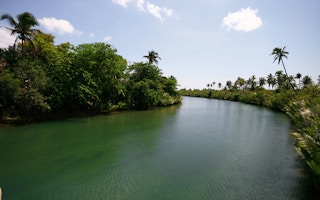Investments in watershed services (IWS) are highest in Asia, with China leading the most transactions in 2012, according to the latest report released by Forest Trends.
To continue reading, subscribe to Eco‑Business.
There's something for everyone. We offer a range of subscription plans.
- Access our stories and receive our Insights Weekly newsletter with the free EB Member plan.
- Unlock unlimited access to our content and archive with EB Circle.
- Publish your content with EB Premium.
With global risks facing the water sector and the fundamental need for clean water in all societies, payment for the protection of the natural infrastructure of watersheds has reached US$8.17 billion in 2011, the US-based NGO said in the report.
The report estimates that through these investment programmes, “3.4 million pounds of nitrogen and 97,000 pounds of phosphorus were kept out of global waterways in 2011, where they would have led to algal blooms and oxygen-starved ‘dead zones’.”
In the second installment of the series, “State of Watershed Payments”, the report stated that China has the most number of transactions responding to the global risks facing water systems, mainly due to increased funding for ‘eco-compensation’, a policy mechanism placed by the government.
As there are varying schemes in different countries in terms of implementing IWS, the researchers broadly identified IWS to include payments for ecosystem services, payments for watershed services, water quality trading markets, and reciprocal or in-kind agreements.
China’s eco-compensation refers to direct payments from the government to individual and community suppliers of watershed ecosystem services, to ensure and improve ecosystem service provision. It also may cover compensation to households, communities, or regional governments that enforce regulations associated with the environmental policy.
“
“A recent CDP survey of Global 500 firms found that two-thirds had targets for internal water management within their direct operations, but just four per cent had set goals for managing water risk in their supply chain, and only three per cent did so for risk at the watershed level
Genevieve Bennett, one of the authors of the report
With all watershed investment programmes taking place in 29 countries, 91 per cent of payments in 2011 took place in China.
Through Forest Trends’ Ecosystems Marketplace initiative, the 2012 report has tracked 205 programmes around the world, with more than half of the programmes located in China (61) and the United States (67). Several notable projects in Asia were also tracked by the group in Japan, three countries in Southeast Asia and three in South Asia.
In Southeast Asia, the study tracked significant investments with eight active programmes in Indonesia and five in the Philippines, while nine new developments are coming up in between these two countries. The programmes reported at least US$55,000 investments in 2011 and US$4.9 million to date, with a total of 111,655 hectares confirmed under watershed management.
The report also presented Vietnam’s policy approach through the national Forest Protection and Development Fund, launched in 2011. For example, under the new policy, four categories of watershed services buyers were required to compensate local communities for watershed benefits, including water and electric utilities and tourism operators.
In these countries, data also show that the percentage of investments that come from governments comprise 25 per cent, water utility has 25 per cent, hydropower operators share 19 per cent, business and industrial users also take 19 per cent and six per cent each from household water users and electricity users.
In Japan, four programmes are identified with mostly involving a city protecting its source water supplies.
Meanwhile in South Asia, the report named four programmes, each coming from India and Pakistan, and two from Nepal. Compensation for protecting watershed services in this region is often linked to water infrastructure development like dams, and has a strong socio-economic development component. But Forest Trend sees the four programmes in the subcontinent region emphasizes on benefit-sharing from watershed development.
IWS as nature-based solution to water risks
Forest Trends supports the idea that maintaining ecological systems to support water quality or supplies is far more cost effective in some cases than investing in grey infrastructures such as storage reservoirs, piped drainage, and water treatment systems.
However, investments to ecological solutions, particularly in watershed protection have been a domain of the public sector and international non-government organisations.
“A recent CDP survey of Global 500 firms found that two-thirds had targets for internal water management within their direct operations, but just four per cent had set goals for managing water risk in their supply chain, and only three per cent did so for risk at the watershed level,” Genevieve Bennett, one of the authors of the report wrote in a recent article.
The report suggests private sector globally has still very little investments in the sector, with less than one per cent of the estimated US$8 billion funds. “In the European Union, Africa, and Southeast Asia, the private sector is actually the most common backer of projects – a striking finding in a field dominated by the public sector. Altogether, companies have spent $94-100 million to date on watershed protection and restoration,” Bennett said.
But Bennett noted that businesses are beginning to notice the trends on ecological investments. With the current climate scenario, Bennett foresees further growth in the sector in 2014, owing it to the growing profile of natural capital in the business world.










